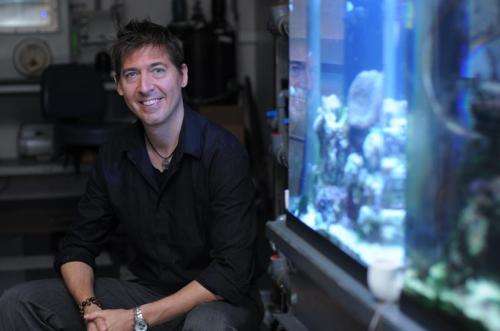Mantis shrimp, toucan and trilobite, oh my

A team of researchers led by a University of California, Riverside professor of engineering have been selected to receive a $7.5 million Department of Defense grant to uncover fundamental design rules and develop simple and basic scientific foundations for the predictable design of light-weight, tough and strong advanced materials inspired by a wide diversity of structures from plants and animals, including the mantis shrimp, toucan and bamboo.
"We are taking what biological systems have constructed over millions of years and coming up with design rules that nature hasn't really thought of," said David Kisailus, the lead researcher on the grant who holds the Winston Chung Endowed Chair of Energy Innovation in the department of Chemical and Environmental Engineering and Materials Science program at the UC Riverside's Bourns College of Engineering and is a Kavli Fellow of the National Academy of Sciences.
Kisailus assembled the multidisciplinary team, whose six co-principal investigators consist of chemists, materials scientists, mechanical engineers and biologists. They are: Cheryl Hayashi, a professor of biology at UC Riverside; Joanna McKittrick and Marc Meyers, both professors in mechanical and aerospace engineering and the materials science program at UC San Diego; Robert Ritchie, a distinguished professor in materials science and mechanical engineering at UC Berkeley; Pablo Zavattieri, an associate professor of civil and mechanical engineering at Purdue University; and Horacio Espinosa, the James N. and Nancy J. Farley professor in manufacturing & entrepreneurship in mechanical engineering at Northwestern University.
In addition, the team includes collaborators with broad backgrounds. They are Professor Nigel Hughes, a paleobiologist in earth sciences at UC Riverside; Elaine DiMasi of Brookhaven National Laboratory; Rajesh Naik and David Mollenhauer, both of the Air Force Research Laboratory; Brad Hollingsworth of the San Diego Natural History Museum; Gabriel Miller of the San Diego Zoo; and Alan Leukhardt of Safariland, a designer and manufacturer of military, law enforcement and sporting equipment.
The funding, which will be distributed over five years, comes from the Department of Defense Multidisciplinary University Research Initiative (MURI) program. This particular grant, managed by Hugh DeLong, department head of complex materials & devices, comes from the Air Force Office of Scientific Research, one of the military research offices which awards MURI grants.
With the funding the researchers will study more than 20 organisms, including mammals, reptiles, birds, fish, mollusks, crustaceans, insects and plants. Examples include: light-weight, tough and durable materials with cellular structures such as the stem of bamboo; the beak of a toucan; layered structures from shells of marine snails and antlers from mammals; twisted plywood structures found in crustacean structures such as the club of mantis shrimp; and insect cuticles.
These structures are particularly interesting because they are composed of relatively simple biological materials such as keratin found in fingernails, yet display incredible mechanical performance. The team will also reach back in history, looking at dynamic evolutionary processes such as the structure of the extinct trilobite, which existed for more than 200 million years by adapting to its environment.
The research program utilizes four interwoven thrusts, including the ultrastructural and mechanical investigation of these organisms, development of mathematical models of their structures and new design, fabrication of biomimetic structures that emulate features found in both natural systems and theory-based designs in order to underpin their tough, strong structures. Finally, the team will conduct comparative evolutionary analyses to pinpoint design principles that are unique and those, which have arisen convergently.
Michael Pazzani, UC Riverside's vice chancellor for research and economic development, whose office provided $70,000 in seed funding to Kisailus and Hayashi for their joint research, is pleased that a UC Riverside professor is leading this project with experts from some of the nation's finest research institutions.
"This multidisciplinary research will highlight the value in biologically-inspired materials allowing the next generation of materials development to take advantage of what nature has known for millennia," Pazzani said.
Provided by University of California - Riverside